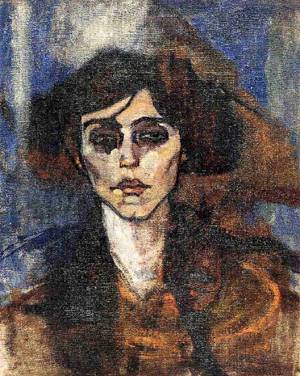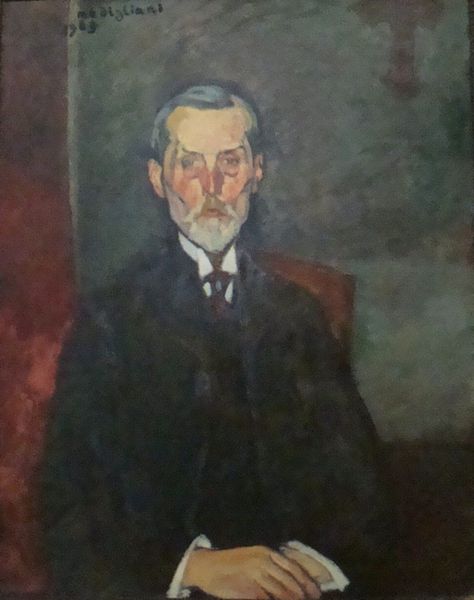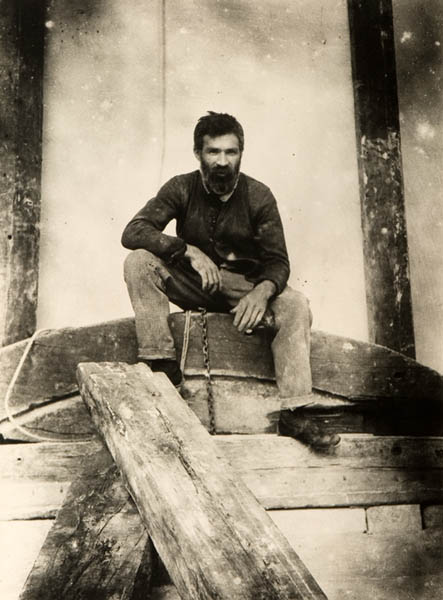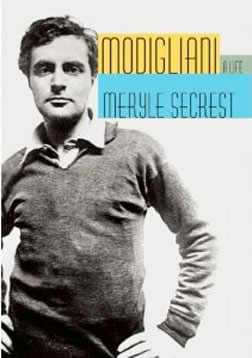As a grown man, Modigliani was only five foot three, although this was closer to the average height than it is today. He was involved in a continuous succession of love affairs, apparently only with women, although when he was a student he refused to join the others on their visits to brothels. "Somewhat later, it is said, it was a point of pride for Modigliani to talk about how many brothels he had visited." He was also a bit of a dandy, especially while his uncle Amédée was paying the bills.
In the spring of 1901, he and his mother returned to Livorno, but he then persuaded his uncle to pay his expenses to study in Florence and then to spend the winter in Rome. When he returned to Florence in early 1902, he came down with scarlet fever, and after being nursed through the illness by his mother, spent some time convalescing in the Austrian Alps. In the spring of 1903, he went to study in Venice, where he became acquainted with the painter and sculptor Umberto Boccioni, as well as the artists Fabio Mauroner, Mario Crepet, Cesare Mainella, Guido Marussi, Ardengo Soffici, and Guido Cadarin.
 |
| Tino di Camaino, Carità, 1321 (Source) |
It was the Chilean artist Manuel Ortiz de Zarate who filled him with the idea of going to the center of the art world, Paris. Ortiz was not particularly impressed with Modigliani's painting at the time, but that may have been because Modigliani wanted to become a sculptor. Jeanne Modigliani, Amedeo's daughter, later wrote that her father had been inspired to become a sculptor by his visits to churches in Naples, and by the work of the fourteenth-century sculptor Tino di Camaino in Siena and Florence. Modigliani went to the marble quarries in Carrara, but gave up marble for the less expensive stone, producing several sculpted heads before he decided to turn to painting again.
Fabio Mauroner recalled that in Venice Modigliani "would spend the evenings, and stay late into the night, in the remotest brothels where, he said, he learned more than in any academy." In his work, Mauroner says, Modigliani was looking to simplify the line, "which he saw as having a spiritual value ... as a solution to his search for the essential meaning of life. But while he was in Venice this ambition was hardly more than a vague abstract idea in his mind." Others recall how in conversation with Modigliani "a discussion of the practical problems of technique and composition would take a sudden turn and start examining the riddle of existence."
Early in 1905, Amédée Garsin, Modigliani's benefactor, died, leaving him a small inheritance that supported him for the next three years. In January 1906, according to Jeanne Modigliani, he made the move to Paris, arriving, Secrest says, "in style, as witnessed by numbers of his friends, who thought he had been left a fortune by a rich uncle." Others, however, claim that he didn't move to Paris until the fall of that year.
The Paris Modigliani found during the Third Republic was a city in dynamic flux, one of boundless opportunity.... As part of their transforming revolution the Impressionist -- Manet, Monet, Caillebotte, Cézanne, Degas, Morisot, Renoir, and Sisley -- brought a new sense of daily life, real people in real situations. The year of Modigliani's arrival Cézanne had just died -- of hypothermia, after being caught in a storm at age sixty-seven -- painters like Bonnard and Vuillard were developing their theories about flat planes of color, and an even more radical group, Matisse, Derain, Vlaminck, and Rouault, had introduced their own movement at the Salon d'Automne in 1905. Their resulting canvases quickly earned them the name of "Les Fauves" -- "Wild Beasts." Picasso and his Cubistic conundrums were just around the corner.Modigliani enrolled in classes at the Académie Colarossi, where Rodin, Whistler, and Gauguin had studied, as well as Ortiz de Zarate, "who no doubt recommended it to Modigliani." Ludwig Meidner, a friend from the time, remembered him "painting very small portraits on rough canvas or smooth card with thin colors," some of which he "covered with ten coats of varnish and, with their transparent golden appearance, recalled the Old Masters." Some were put on display in a gallery in December 1906, but none of them sold. Meidner remembered that Modigliani was constantly drawing and that he developed his own technique:
"He drew from life on thin paper, but before it was finished he placed another white sheet beneath it and a piece of graphite paper between the two; then he traced the drawing, greatly simplifying the lines.... Whereas in later years he developed his own style of painting, his drawing remained essentially unchanged. Once he set to it, he could produce dozens of portraits in this way."Modigliani also made a friend of the artist Anselmo Bucci, who saw the portraits in the gallery and sought him out. Bucci recalled Modigliani claiming that the only good painter in Italy was Oscar Ghiglia, and that he singled out Matisse and Picasso in France -- and almost added himself. Meidner recalled that Modigliani was interested in the works of Gauguin and Whistler, and that in addition to Matisse and Picasso, "He also admired Ensor and Munch, who wee almost unknown in Paris," as well as "some of the young Hungarian Expressionists who were just coming into favor." Another friend, Gino Severini, wrote about their discussions, "Impressionism no longer satisfied [us]; Picasso was too much of an intellectual.... Modi never agreed with anyone. And in particular, he didn't agree with Futurism. Futurism was based on color relationships, on a certain impressionism. Modigliani didn't give a damn about all that. He was interested in the Genovese primitivdes, in Negro art, in the Venetians."
In the winter of 1906, Modigliani moved into the center of the artists' quarter in Montmartre, in what the poet Louis Latourette recalled as a "shanty ... in a state of wild disorder." He also rented a studio that Meidner called "a tumbledown shake on a treeless, ugly scrap of ground, and although it was furnished in the most spartan manner, oppressive and neglected like a beggar's hovel, one was always glad to go there for one found an artistic atmosphere in which one was never bored."
But the center of the bohemian life was a café called the Lapin Agile.
 |
| Au Lapin Agile, 1880-1890 (Source: Wikipedia) |
 |
| Henri de Toulouse-Lautrec, poster, 1892 (Source: Wikipedia) |
 |
| Gill's rabbit (Source) |
Along with the small-time criminals who had frequented Les Assassins [the name of the club under its previous owner], there were poets like Guillaume Apollinaire and Max Jacob, writers like Francis Carco and André Salmon, and, most of all, artists: Picasso, Braque, Derain, Vlaminck, Valadon, Utrillo, Gris, and so many others. With his usual perspicacity Modigliani at once attached himself to the list.
 |
| Secrest:
"Modigliani made himself a part of the new crowd with ease. He had the
rare gift of being perfectly delighted in any company. One sees this in a
series of candid camera photographs taken by Cocteau during World War
I.... Modigiliani is all eager attentiveness as Picasso explains a joke
to André Salmon to which, no doubt, he is about to add an irresistible
coda." (Image source) |
Almost everyone of artistic prominence, with the exception of Matisse and Vlaminck, lived in Montmartre. Picasso, Juan Gris, and Kees van Dongen resided in a former piano factory called the Bateau Lavoir, a "squalid tenement" with rent that even an artist could afford, which is why Modigliani eventually moved in too.
 |
| Picasso's
biographer John Richardson described the Bateau Lavoir as "so
jerry-built that the walls oozed moisture ... hence a prevailing smell
of mildew, cat piss and drains.... On a basement landing was the one and
only toilet, a dark and filthy hole with an unlockable door ... and
next to it, the one and only tap." (Image source) |
He could also rely on the generosity of Rosalie Tobia, who had once been a nude model but was now "completely shapeless." She ran a small restaurant, Chez Rosalie, and was sympathetic to starving artists. Modigliani was one of her special favorites, though they also had frequent fights over his inability to pay the bills. He sometimes paid her in drawings, as did other artists. "The legend, probably true, is that she kept them, covered with grease, in a kitchen cupboard, the rats gnawed away at them, and when she thought of cashing them in it was too late." On her walls were paintings by Modigliani, Picasso, and Utrillo, and Modigliani once painted a fresco on one of her walls that she disliked and had it whitewashed over.
Modigliani was also "thinking of giving up painting and going back to sculpture." He would "court the masons working on new buildings over a bottle of wine and then make off with a block of stone." But he was not yet ready to give up painting. In 1907 he exhibited seven works at the Salon d'Automne, but sold none of them. The same exhibition also featured forty-eight paintings by Cézanne, who had died the year before, and Modigliani was dazzled by them. He carried in his pocket a reproduction of one of Cézanne's several paintings of a boy in a red vest. In the same year, he saw the pioneering Cubist painting Les Demoiselles d'Avignon in Picasso's studio, a work that even Picasso's contemporaries failed to appreciate at first sight. "Modigliani admired Picasso without reservation. 'How great he is,' he once remarked. 'He's always ten years ahead of the rest of us.'"
 |
| Pablo Picasso, Les Demoiselles d'Avignon, 1907 (Source) |
 |
| Amedeo Modigliani, Portrait of Paul Alexandre, 1909 (Source) |
 |
| Secrest: "Her features, well marked and handsome, are notable for the eyes, which are disproportionately large, and smudged with blotches of paint as if to indicate mute suffering." (Image source) |
 |
| Secrest: "The old man confronts the viewer with grave distinction, his white beard precisely trimmed to reveal a pink bottom lip, his eyes tired but calm. He has a natural authority and so does his son, who strikingly resembles him." (Image source) |
There was much drinking and drug-taking at the Alexandre salon, but many witnesses assert that Modigliani did not drink excessively, and although he participated in the experimentation with drugs, especially hashish, he "seldom drew while taking hashish, preferring to recall his visions in sobriety with the aim of reproducing the heightened effect."
 |
| Constantin Brancusi, 1905 (Source) |
[Herbert Read wrote,] "Brancusi strove to find the irreducible organic form, the shape that signified the subject's mode of being, its essential reality." Searching for the reality behind appearances: this, in Modigliani's case, was wedded to his belief in art as a magical force offering the path to exorcism and transfiguration.Modigliani had become the prototypical bohemian, careless with money, given to reckless behavior, but enduring despite the sometimes self-imposed hardships. For "the belief that art was still a noble cause, in stark contrast to the grubby, money-focused goals of the bourgeoisie, when to the heart of the Bohemian creed.... It did not seem to matter to Modigliani that he was hounded by debts, sleeping on the run, with no money for good and no buyers for his drawings. He was surviving somehow."

No comments:
Post a Comment